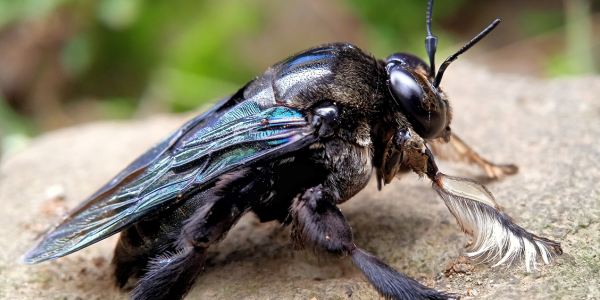
10 Buzzy Carpenter Bee Facts
As a New York homeowner, you may have encountered carpenter bees buzzing around your property. These fascinating creatures are often mistaken for bumblebees due to their similar appearance. However, carpenter bees are unique in their own right.
In this blog post, we will explore 10 interesting facts about these buzzing insects and, by the end, you may just appreciate them a bit more.
1. Carpenter Bees Are Not Bumblebees
Although they resemble bumblebees, carpenter bees have shiny, hairless abdomens, while bumblebees have fuzzy, hairy abdomens. Carpenter bees are also larger than bumblebees!
2. They Get Their Name from Their Nesting Habits
Carpenter bees are named after their unique nesting behavior. They use their strong jaws to create tunnels in wood, where they lay their eggs and raise their young.
3. Carpenter Bees Are Solitary
Unlike honeybees, carpenter bees are solitary insects. Each female carpenter bee creates her own nest, and the males do not participate in the care of the young.
4. Carpenter Bees Create a “Buzzing” Sound When Boring into Wood
Carpenter bees create a distinctive buzzing sound when they bore into wood to make their nests. This sound is produced by the rapid vibration of their wings as they use their strong jaws to excavate the wood.
5. Male Carpenter Bees Cannot Sting
Male carpenter bees are often seen hovering around their territory, protecting it from intruders. However, they are harmless, as they do not have a stinger.
6. Female Carpenter Bees Can Sting But Rarely Do
Female carpenter bees do have a stinger, but they are not aggressive and will only sting if they feel threatened or are handled roughly.
7. Carpenter Bees Are Not Wood-Eaters
Despite their wood-boring habits, carpenter bees do not eat wood. They create tunnels in wood to lay their eggs, but their diet consists of nectar and pollen from flowers.
8. Carpenter Bees Prefer Softwood
Carpenter bees prefer to nest in softwoods such as pine, cedar, and redwood. However, they can also be found in hardwoods if the wood is weathered or unpainted.
9. Carpenter Bees Have a Long Lifespan
Carpenter bees can live up to three years, which is quite long for an insect. During their lifetime, they can create several nests.
10. Carpenter Bees Have Few Natural Enemies
Carpenter bees have few natural predators. Woodpeckers are one of the few creatures that will feed on carpenter bee larvae by drilling holes into the wood to access the nests.
Knock Out Carpenter Bees This Spring and Summer
While carpenter bees are fascinating creatures, they can cause damage to your property. If you’re a New York homeowner experiencing a carpenter bee infestation, trust Knockout Pest Control to provide a safe and effective solution. Our experienced technicians will assess the situation and develop a customized plan to protect your home from these wood-boring insects. Contact us today to schedule a consultation and let us help you keep your home safe from carpenter bees this spring and summer!



